According to research published in Proceedings of the National Academy of Sciences (PNAS), carbon storage capacity in forests worldwide is only 88% of its potential. The study aims to assist in prioritizing areas for boosting reserves.
 Aerial view of the Amazon rainforest near Manaus city, Amazonas, Brazil. Researchers say forest systems act like sponges, sequestering carbon dioxide from the atmosphere. Image Credit: Neil Palmer/CIAT, (CC BY-NC-ND 2.0).
Aerial view of the Amazon rainforest near Manaus city, Amazonas, Brazil. Researchers say forest systems act like sponges, sequestering carbon dioxide from the atmosphere. Image Credit: Neil Palmer/CIAT, (CC BY-NC-ND 2.0).
According to experts from the Woodwell Climate Research Center in the United States, the results might help to develop climate change strategies since forest systems operate like sponges, absorbing carbon dioxide from the atmosphere.
According to the study, better forest management, such as preserving native tree species and forbidding logging, might help realize nearly three-quarters of this untapped potential, the bulk of which (71%) is located in the tropics.
Brazil, Indonesia, the Democratic Republic of Congo, India, and Mexico are among the top 10 countries with the highest potential.
The size of the untapped reservoir—the space on land that is available for additional carbon storage—is considerable: about 287 petagrams (PgC) after we set aside land that is critical to food production and human habitation.
Wayne Walker, Study Author and Associate Scientist, Woodwell Climate Research Center
One billion tons is equivalent to one petagram (PgC).
The majority of this untapped potential is found in woody biomass (78%) and soil (22%), which used existing data, field measurements, and geospatial imagery to quantify the gap between present and prospective carbon storage.
Global emissions must stay below 250 PgC to satisfy the Paris Agreement’s goals of preventing average temperature increases of more than 2 °C above pre-industrial levels. The authors noted this amount would be attained by 2045 at present rates.
Researchers suggest that understanding carbon storage capacity is critical for advancing “nature-based” climate solutions like forest maintenance, improved management of degraded ecosystems, and restoration—reforesting where native forests have been cut.
According to Walker, the findings reflect the high rates of previous deforestation and forest degradation in the tropics.
Generally speaking, countries with greater forest loss have larger land-carbon deficits and greater unrealized potential for additional carbon storage.
Wayne Walker, Study Author and Associate Scientist, Woodwell Climate Research Center
Some of the study’s results are opposed by David Lapola of the Center for Meteorological and Climate Research Applied to Agriculture in Campinas, Brazil.
Long-term observational data is showing that the carbon sink strength in the Amazon has reduced 30% since the 1990’s. Should that trend persist, the world’s largest tropical forest will turn into a carbon source to the atmosphere in about 15 years. So how can we expect these forests to absorb even more carbon when there are projections saying their current carbon stocks won’t persist?
David Lapola, Center for Meteorological and Climate Research Applied to Agriculture
Among the efforts needed to combat climate change, he added, was the preservation of existing forests and woody ecosystems, as well as the restoration of degraded ones.
Lapola added, “But I don’t think we should count only on that to take us out of the planetary-scale problem we created.”
The size of carbon reserves will be affected by changes in temperature and precipitation.
“Across the tropics, the size of the available reservoir is likely to decrease,” stated Lapola.
According to the study, restoration represents less than 10% of possible climate benefits (connected to carbon storage) in Brazil. As per the report, the biggest advantages will come from concentrating efforts in areas where forest cover has been preserved at least partially.
The study authors stated, “Any attempt to compensate an emission with an equivalent elimination will lead to an atmospheric concentration higher than if the emission had been avoided from the beginning.”
Lapola also cautions about the dangers of polluting governments or businesses utilizing carbon credit programs to “offset” emissions “as a permission to keep emitting.”
He stated that the study follows the prevalent line of argument that tropical countries have primary responsibility for reducing carbon emissions and that land tenure and finance concerns are not addressed.
According to Lapola, actions needed to stop deforestation are “relatively easy and Brazil has demonstrated in the past that it is doable, but to contain degradation, we still have to understand way more deeply its causes and implications.”
He also emphasized the need of advancing carbon capture and storage methods, as well as REDD+ programs, which give financial incentives for poor nations to protect rather than deforest.
Lapola added, “Global climate change, differently from deforestation and degradation, is not only up to tropical countries to solve. If there is no concerted global action to reduce emissions, tropical forests will suffer the impacts of climate change even if deforestation and degradation are curbed.”
Journal Reference:
Walker. W. S., et al. (2022) The global potential for increased storage of carbon on land. PNAS. doi:10.1073/pnas.2111312119.